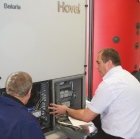Planning for smooth boiler commissioning

Delays in the commissioning of hot-water boilers can have serious implications for project timelines. Kevin Stones of Hoval highlights the key pre-commissioning measures that should be taken to minimise the risk of unnecessary delays.
It is an unfortunate fact that the commissioning of hot-water boilers is occasionally delayed because the necessary pre-commissioning measures weren’t taken in advance of the commissioning engineer’s visit. Such delays are not just inconvenient (and potentially costly), but they can also have an impact on the overall schedule of a boiler installation project.
The purpose of this article is to highlight the key measures that should be taken in preparation for the commissioning engineer’s visit. Some of these may seem obvious — such as having sufficient lighting and ventilation in the boiler house to complete the work — but it’s surprising how often even the most obvious factors are overlooked in the midst of a busy project. In the case of boiler-house ventilation, it is essential that this meets the requirements of current legislation.
In terms of the system components, it is essential that suitable safety valves, together with associated discharge pipework, are fitted in the correct locations. For example, in the case of gas-fired condensing boilers, commissioning engineers should not commission unless an air-admittance valve (AAV) is fitted on the top calorifier/safety valve connection pipe and the system is fully filled and vented.
 |
| Even before commissioning work starts on a boiler installation, there are many preparations to be made. |
In addition, drain pipework for the boiler flue box needs to be fitted correctly and trapped. For condensing boilers, condensation pipework, complete with trap, must be in place. All flue components should also be fitted and sealed correctly, with traps fitted to any drain-off points. Any dampers in the flue between the boiler and the chimney (if fitted) need to be in the open position. Manually operated dampers should be locked in the open position. For electronically operated dampers, the burner must be interlocked electrically to prevent operation until the damper is open.
Systems associated with the boilers will need to be checked. For instance, all electrical work, including any associated external sensors, should be connected to the boiler control panel. Other equipment associated with the boilers, such as pressurisation units and the building-management system (BMS) will need to be installed, commissioned and interlocked with the boilers before the boilers themselves are commissioned.
For the commissioning process, there must be sufficient water pressure available to meet minimum requirements, as stipulated by the boiler manufacturer for the types of boiler being used. The boiler will also require sufficient fuel to be available to meet the capacity of all available equipment at full output and, most importantly, for gas-fired appliances at the required minimum gas pressure. For boilers with dual-fuel burners, this requirement applies to both fuels.
|
Pre-commissioning checklist: Addressing the following pre-commissioning checks will help to ensure that commissioning goes smoothly and without delays. • Adequate lighting and ventilation in boiler house. • Suitable safety valves (including air-admittance valves if required) are installed. • All flue work, pipework and traps are in place. • Spirals/retarders placed in boiler flue tubes (shell boilers) • Other manufacturers’ equipment installed, commissioned and interlocked. • Electrical work, including sensors, connected. • Correct water pressure available. • Sufficient fuel (gas, oil, biomass) available. • Required certificates available. • Sufficient heat load available. • A suitable heating system water treatment regime is in place. |
Similarly, with biomass boilers there should be sufficient wood fuel in the bunker/hopper for the duration of the commissioning period.
In the case of gas-fired boilers, the gas line will need to be purged, soundness-tested and strength-tested up to the boiler isolation valve. The commissioning engineer will need a copy of the certificate, in accordance with IGE-UP-1, and will not be able to proceed if this is not available. On oil-fired boilers there needs to be a filter and flexible oil supply pipeline in place.
Of course, there will also need to be sufficient load available in the building to run the boilers at part and full-load for the duration of the commissioning period, which will typically be several hours.
For all types of boiler it is important to ensure that adequate clearance is provided to be able to fully open the boiler door for inspection and maintenance. In the case of shell boilers fitted with a pressure-jet burner, the electrical flying lead to the burner should facilitate boiler-door opening.
It is also extremely important to have in place a suitable treatment regime for the water in the heating system prior to operating the equipment concerned.
Given the potential issues arising from delayed commissioning, there are very sound commercial and operational incentives for ensuring that all necessary preparations are taken. This article covers the main points. Your boiler manufacturer should be able to facilitate the process by providing a check list that relates to the type of boiler(s) being commissioned.
Kevin Stones is engineering and service director with Hoval.







